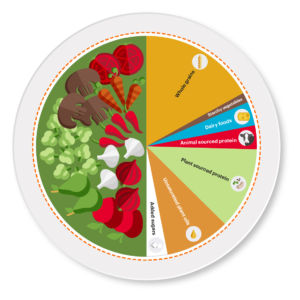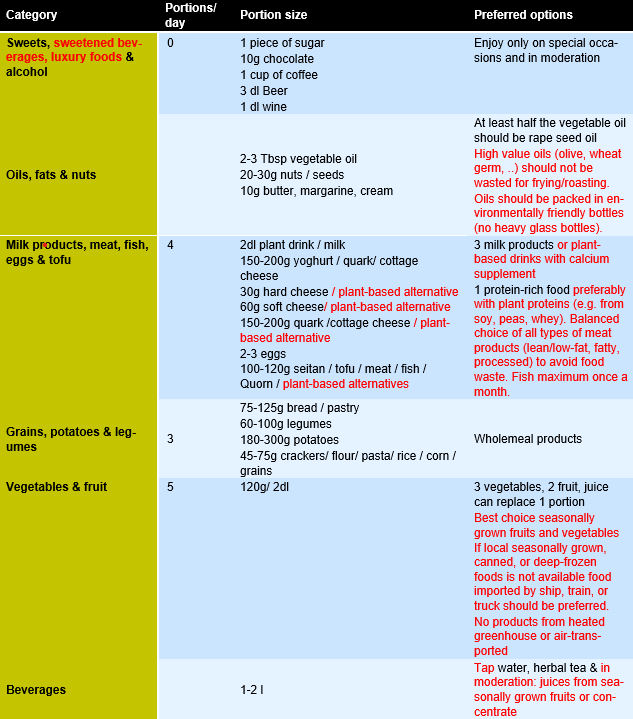Analysis of environmental impacts as a scientific basis for Swiss dietary recommendations
Dietary recommendations guide consumer and teachers on food choices. Nutrition has an impact on human health and the natural environment. Its share of the environmental impact of Swiss final consumption is 20-25%. This depends on the impact assessment method. This environmental damage affects human health. For example, periods of heat in summer lead to deaths due to the climate crisis. If nutritional recommendations only focus on one of the two aspects, both, human health and the environment suffer. ESU-services prepared a report that merges both aspects of nutrition, to ensure sustainability in a healthy and environmentally friendly way. With this we follow similar approaches like the planetary health diet.
Background for the revision of Swiss dietary recommendations

The Federal Food Safety and Veterinary Office (FVSO) initiated in 2020 a revision of the Swiss dietary recommendations. They commissioned ESU-services for the lead of the “sustainability” in work package number of the project “Dietary recommendations for the Swiss population”. ESU started conducting the Analysis of food and environmental impacts as a scientific basis for Swiss dietary recommendations. During the project, there turned out to be different opinions about the prioritization of health and sustainability aspects. Because of this, the cooperation with ESU-services was terminated by the commissioner CHUV without payment for the planned report.
LCA (life cycle assessment) based research on environmentally friendly nutrition is an important working field of ESU-services for more than 25 years. Thus, ESU-services compiled a full report on this theme from own resources based on this long-term experience.
Key questions to develop sustainable nutrition
The report provides a scientific basis for the dietary recommendations in Switzerland. It answers the following key questions:
- What is the environmental impact of different foods, and which ones have particularly high environmental impacts?
- What synergies or conflicting goals exist between health and environmental sustainability in terms of nutrition?
- How can the conflicting goals be solved?
- Which results regarding synergies and conflicting goals are of importance for Switzerland?
- How can this be considered in the revision of the nutritional recommendations?

A life cycle assessment (LCA) is performed on a list of food items to to evaluate the environmental impact of food (consumption). The ecological scarcity 2021 method is used for the impact assessment. The LCA includes the production, processing, transport, storage, and distribution up to and including the supermarket.
Different functional units are chosen to cover the different nutritional functions of the studied food items. Environmental impacts are calculated per 100 g, per 100 kcal and per nutritional value of the food.
Results of the environmental assessment

When using mass as the functional unit, animal and oil products lead to the highest environmental impacts of the food items. Concerning their calorific value, especially meat products and fish lead to higher impact compared to the other food groups.
For each nutritional value, specific types of food are pointed out which can cover the recommended daily intake in a environmentally friendly way. The daily demand of proteins, for example, can be covered by grains without causing the high environmental impacts of meat consumption.
The results from the LCA are supported by a discussion on the distinct phases of the life cycle of the food products. The environmental impact depends on the way of production, processing, transportation, storage etc.. The analysis increases the understanding on how these aspects influence environmental impact. A relevance matrix shows that for most product groups, the agricultural production has the highest impact throughout the life cycle of food products.
Conflicts and synergies between environmental and health related issues
With the results from the impact assessment of the food items, conflicts and synergies between health and environmental sustainability are described for different food items covered in this study. Most of the conflicts can be solved by using alternative products. Animal products can be replaced with meat substitutes or other plant products to cover a certain nutritional function.
From the results of the LCA on food items and the discussion on its life cycle phases, improvement potentials for the production and consumption of food are pointed out. A reduction of environmental impact can be achieved by the adaption of production processes in an environmental friendlier way. Either this is implemented through policy measures or through a change in consumption behavior of the consumer. Reducing the consumption of animal products shows the highest reduction potential. To ensure sufficient provision of nutrients, their daily recommended intake can be covered with meat substitutes or other plant-based products. For plant-based products, consuming seasonal and local products, reducing energy intensive processing steps and packaging help to prevent environmental damage. Minimizing food waste in the life cycle of food has a reduction potential for environmental issues without conflicting health aspects. Finally, reducing overconsumption is an effective measure to reduce environmental impact and improve human health.
Conclusions for the further development of Swiss dietary recommendations
The report concludes with an adapted version of the Swiss nutritional recommendations, containing the sustainability aspects elaborated in this study. The proposed revisions for the Swiss recommendations according to this report are shown in the following table.
We recognized that it is necessary to address different target groups in the population with different nutritional demands, while working on these recommendations. Especially for the single nutrients, daily recommended intakes can be higher than what can be achieved with a normal diet. Thus, these recommendations need further revisions and adaptation to the needs of e.g. children, women, men, elderly, active, or other groups of population.

Life cycle assessment of the new Swiss dietary recommendations
On September 11, 2025, the new Swiss dietary recommendations were published. It makes sense to look at them in the original long version and not judge them based on media releases or newspaper reviews. For us, this raised whether the new dietary recommendations adequately consider environmental aspects. ESU-services, with the support of WWF Switzerland and Greenpeace, has developed a life cycle assessment and evaluation of the new Swiss dietary recommendations.
The new Swiss dietary recommendations, if implemented with environmental awareness, could contribute to reducing environmental impacts. However, they leave a lot of decision-making power to consumers. Therefore, the recommendations alone will not be sufficient to achieve the already decided environmental goals, such as significantly reducing greenhouse gas emissions. Environmental impacts must also be reduced at the level of food production. The process for environmentally conscious production and consumption must therefore be more clearly promoted politically. Read more in the ESU post: Review of the new Swiss dietary recommendations
Publications and discussion
We see sustainable development as an ongoing and discursive process. Therefore, we are happy to receive comments and suggestions for improvement for a possible revision of this report.
ESU post: Review of the new Swiss dietary recommendations
Niels Jungbluth, Angelo Steffanel (2025) Ökobilanz der neuen Schweizer Ernährungsempfehlungen. ESU-services GmbH im Auftrag von greenpeace und WWF Schweiz, Schaffhausen, Schweiz
Niels Jungbluth, Ujué Fresán (2024) Topical discussion session 4: Recommendations for sustainable dietary patterns in the political debate. Moderation for the 14th LCA Food international conference, 8 – 12 September 2024 Barcelona, Spain
Niels Jungbluth, Catarina Rocha (2023) Life cycle assessment of novel plant products compared to animal products. EcoSystem meeting on the 4th of April, Life Cycle Assessments (LCA’s) – The holy grail to foster change and convince consumers? Online
Niels Jungbluth, Samuel Solin (2022) Life cycle assessment of novel plant products compared to animal products. Parallel Session XV (Sustainable Farming Systems III – Livestock), 13.10.2022, 13th International Conference on Life Cycle Assessment of foods (LCA foods 2022), Lima, Peru
Niels Jungbluth, Martin Ulrich, Karen Muir, Christoph Meili, Maresa Bussa, Samuel Solin (2022) Analysis of food and environmental impacts as a scientific basis for Swiss dietary recommendations. ESU-services GmbH, Schaffhausen, Switzerland.
Jungbluth, N. & Frischknecht, R. 2000: Household Food Consumption Patterns: Part B – Evaluation methodologies and indicators. Sustainable consumption: Sector case study series No. ENV/EPOC/GEEI(2000)9/ANN1, ESU-services for Organisation for Economic Co-operation and Development (OECD), Environment Directorate, Project on Sustainable Consumption, 49 Seiten, Paris.